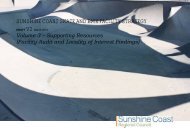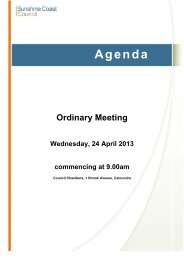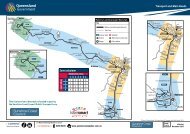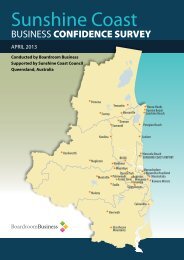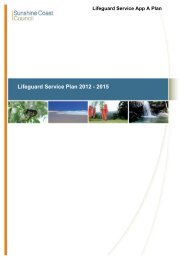Sunshine Coast Aquatic Plan 2011-2026 - Sunshine Coast Council
Sunshine Coast Aquatic Plan 2011-2026 - Sunshine Coast Council
Sunshine Coast Aquatic Plan 2011-2026 - Sunshine Coast Council
Create successful ePaper yourself
Turn your PDF publications into a flip-book with our unique Google optimized e-Paper software.
5.3 Design criteria considerations<br />
Table 15: <strong>Aquatic</strong> facility design provides general design guidance to be utilised when undertaking<br />
any detailed aquatic facility planning, designing any new facility or retro-fitting an existing facility.<br />
Table 15: <strong>Aquatic</strong> facility design<br />
Consideration<br />
Whole of life costs<br />
Financial sustainability<br />
and long term viability<br />
Design and<br />
consultation<br />
Construction<br />
Place making/master<br />
planning<br />
Duplication<br />
Access and safety<br />
Critical principles for new facilities or upgrades<br />
Ensure whole of life estimates are undertaken and a determination of upfront<br />
and ongoing costs are acknowledged and approved by the service and asset<br />
managers before the project commences.<br />
Consider design elements which entice the community to increase their usage,<br />
improve physical activity opportunities, meet existing and changing needs of the<br />
community, and have play areas, programs and therapy in one environment so<br />
that operating costs can be shared and minimised and thus reduce the cost to<br />
the community.<br />
Utilise integrated design and consultation programs, ensuring:<br />
►►<br />
separate consultation and concept processes are undertaken<br />
►►<br />
consultation is consistent with council’s community engagement model<br />
►►<br />
ensure aquatic facilities are integrated with and have minimal impacts on<br />
surrounding land uses<br />
►►<br />
infrastructure design and placement encourages multiple uses and user<br />
groups and social interaction<br />
►►<br />
principles from the Landscape Infrastructure Manual and Crime Prevention<br />
Through Environmental Design are adhered to<br />
►►<br />
only sturdy materials are used and are purpose fit for the intended use.<br />
Incorporate construction principles which have the capacity to contract stages<br />
of work according to the scale of the facility ensuring:<br />
►►<br />
performance measures are in place for any contractor, including asset<br />
maintenance plans, warranties, maintenance manuals and as constructed<br />
and cross sectional drawings<br />
►►<br />
the supply of a maintenance schedule including any spare parts catalogue<br />
and contact details of suppliers and maintenance repairers<br />
►►<br />
sustainable initiatives including solar or backwash water recycling<br />
►►<br />
construction contract processes ensure the final outcomes match the vision<br />
of key stakeholders and ensure high quality outcomes<br />
►►<br />
the incorporation of aquatic signage consistent with standards and best<br />
practice requirements<br />
►►<br />
all materials are appropriate for the location and intended use and, if fencing<br />
is required, specifications must be able to withstand vandalism and site<br />
specific elements.<br />
Integrating aquatic facilities within place making and master planning projects,<br />
where relevant ensuring:<br />
►►<br />
aquatic facility development at key sites should be considered as part of<br />
broader place making processes within council<br />
►►<br />
early integration of contemporary concepts allowing for the greatest benefit to<br />
all potential users and better integrated outcomes.<br />
Avoid ancillary infrastructure duplication and concentrate on ancillary<br />
infrastructure which caters for a diverse range of experiences and uses. This<br />
will ensure a diverse network of opportunities across the region.<br />
Consider the needs of people of all abilities and needs when planning<br />
and designing aquatic facilities and implement Crime Prevention Through<br />
Environmental Design principles to encourage safety.<br />
64 <strong>Sunshine</strong> <strong>Coast</strong> <strong>Aquatic</strong> <strong>Plan</strong> <strong>2011</strong>-<strong>2026</strong>



